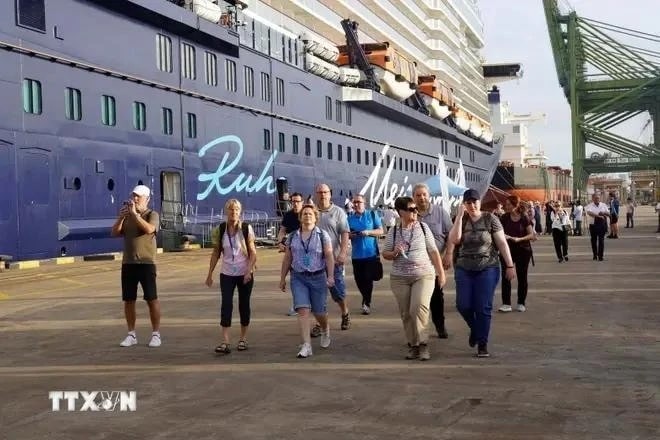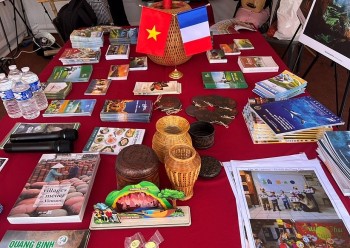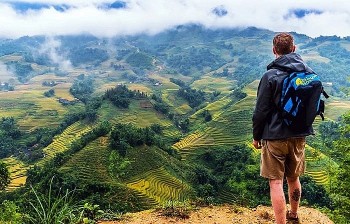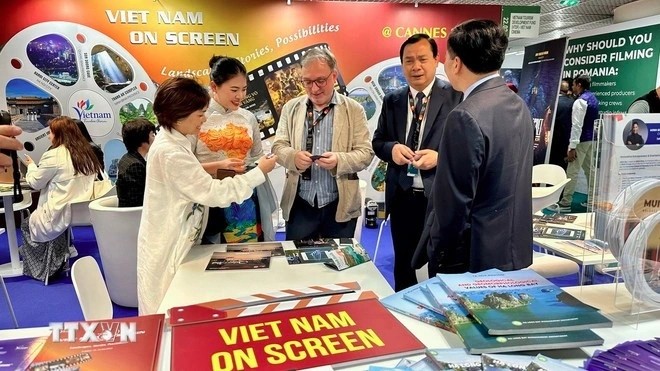Vietnam Aims To Welcome 36 Million International Tourists In 2030
| German Tourists Fall in Love with Vietnamese Cuisine on 5-Star Train to Da Nang | |
| Vietnam News Today (Jun. 15): Vietnam Calls For UNCTAD’s Continued Support For Developing Countries |
Becoming a destination with high tourism development capacity in the world
According to the plan, by 2025, Vietnam will become an attractive destination with high tourism development capacity globally.
By 2030, tourism will truly become a key economic sector, developing towards green growth, and becoming a destination with the world's leading development capacity.
 |
| A group of foreign tourists visited Luon Cave in Ha Long Bay, Quang Ninh during their trip to Vietnam. Photo: Nguyen Hung |
With the specific goal, Vietnam will strive to welcome 25 - 28 million international and 130 million domestic visitors in 2025, maintaining a domestic tourist growth rate of 8 - 9% per year. By 2030, Vietnam can reach 35 million international visitors, growth rate of 13 - 15% per year, welcoming 160 million domestic visitors, with a growth rate of 4 - 5% per year.
The country will strive to contribute 8 - 9% to GDP by 2025 directly. In 2030, the direct contribution will be 13 - 14% of GDP.
Regarding the need for accommodation rooms, Vietnam will provide about 1.3 million rooms in 2025. It can reach 2 million by 2023.
According to the planning, tourism will create about 6.3 million jobs, of which about 2.1 million are direct jobs by 2025. By 2030, it can create about 10.5 million jobs, of which about 3.5 million are direct jobs.
By 2045, tourism will affirm its driving role in the economy and global destination, among the top tourism developing countries in the Asia-Pacific region.
Vietnam will strive to welcome 70 million international visitors with a total revenue of about 7,300 trillion VND, contributing 17 - 18% of GDP. The country is also determined to recover and maintain the growth momentum of the domestic tourist market in the period 2021 - 2025.
From 2026 to 2030, Vietnam will maintain and expand the scale of traditional markets to Northeast Asia, Southeast Asia, Europe, North America, Russia and Eastern Europe, and Oceania, moving towards increasing market share of customers with high-paying ability.
Forming 8 driving regions for tourism development
Regarding product development orientation, according to the scheme, it will utilize marine and island tourism resources to develop products capable of competing with regional countries in marine and ecological resorts. It will also develop high-end beach resort centers with strong brands in the international market.
By 2030, Vietnam will develop 6 driving regions.
The first driving force area for tourism development of Hanoi - Hai Phong - Quang Ninh - Ninh Binh promotes tourism in the Red River Delta and the entire Northern region, diversely linked and mutually helped historical and cultural tourism, and tourism products.
The second driving force area for the tourism development of Thanh Hoa - Nghe An - Ha Tinh creates support in combining a variety of tourism products associated with ecology, world heritage, culture, history, and community tourism associated with ethnic minorities in mountainous areas.
The third driving force area for tourism development of Quang Binh - Quang Tri - Thua Thien Hue - Da Nang - Quang Nam promotes tourism development in the North Central and Central Coast regions, connecting domestic and international world heritage sites, and linking cultural tourism products with urban tourism and beach resorts.
 |
| Cruise tourists arrive at Ba Ria - Vung Tau province. (Photo: VNA) |
The fourth area for tourism development of Khanh Hoa - Lam Dong - Ninh Thuan - Binh Thuan develops tourism based on strengthening the connection between the North Central and Central Coast regions with the Central Highlands, connecting mountain resort tourism with sea resorts, delta culture with the gong cultural space of the Central Highlands.
The fifth driving force area for tourism development of Ho Chi Minh City - Ba Ria - Vung Tau plays a role in promoting tourism development in the entire Southeast region, linking tourism development with the Southern economic corridor.
The sixth driving force area for tourism development of Can Tho - Kien Giang - Ca Mau focuses on promoting tourism development in the entire Mekong Delta region, linking tourism development with the coastal economic corridor.
After 2030, two new dynamic areas will be formed.
The Lao Cai - Ha Giang tourism development area will promote tourism in the entire Northern Midlands and the mountainous areas, connecting with the tourist market in Yunnan (China) and travel along the Kunming - Hanoi - Hai Phong economic corridor.
The Hoa Binh - Son La - Dien Bien driving force of tourist development helps develop tourism for the Northwest sub-region of the Northern Midlands and mountainous areas, linking tourism development along the East-West economic corridor along National Highway 6.
 | Vietnam Promotes Ao Dai, Tourism at Consular Festival in France Within the framework of the Consular Festival 2024, Vietnam impressed attendees with traditional ao dai and tourism products in Lyon, France. |
 | Four Must-Do Activities When Traveling In Vietnam According to Drift Travel Magazine (Canada), Vietnam provides a variety of interesting off-beat experiences that go beyond the usual touch-and-go type of travel. |
Recommended
 Travel
Travel
Vietnam Strengthens Its Presence On The Global Tourism Map
 Multimedia
Multimedia
Phong Nha-Ke Bang National Park Named Top Adventure Travel Site
 Travel
Travel
Vietnam Welcomes Record-High Number of International Visitors
 Travel
Travel
Luxury Train From Hanoi To Hai Phong To Be Launched In May
Popular article
 Travel
Travel
Phong Nha Named Top Budget-Friendly Travel Destination for Spring 2025: Agoda
 Travel
Travel
Four Indian Films Introduced to Lao Cai Audience
 Travel
Travel
Vietnam to Waive Visas for Citizens from 12 Countries until 2028
 Travel
Travel








